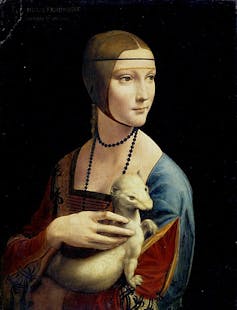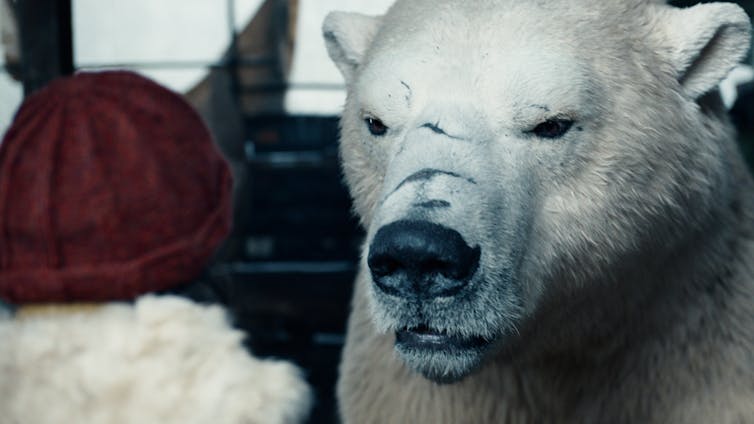
Countries are given archaic spellings: Brytain, Eireland, Corea and Groenland. Alternatively, they are identified by historical names such as Nippon for Japan (from the Japanese “land of the rising sun”) and Cathay for China (from the medieval Latin Cathaya).
The Pacific Ocean is renamed the Peaceable Ocean, a direct translation of the Latin name which it was given in the 16th century in recognition of the calm seas experienced by the explorer Ferdinand Magellan.
In English, scientific terms are typically formed using the suffix -logy; this goes back to the Greek logos (“word, discourse”). Instead, Pullman draws on the Old English practice of using cræft (“skill”) – as in Old English tungol-cræft (“star-skill” or “astronomy”) – hence atomcraft “particle physics”. Scientists are known as philosophers (literally “lovers of wisdom”), drawing on an earlier use of the word to refer to scholars working in any field of research.
Pullman also revives words that have fallen out of use in contemporary English, such as gyropter – from the Greek gyros (“circle”) and pteron (“wing”) – as an alternative to helicopter – from Greek helix (“spiral”).
The photogram – from the Greek photo (“relating to light”) and gram (“written”) – has been replaced by photograph in modern English, while aeronaut – from Greek aer (“air”) and nautes (“sailor”) – was an early term for a balloonist.
Alongside these, Pullman introduces his own coinages, such as the chthonic (or “underground”) railway station and the alethiometer, which Lyra uses to determine the truth (Greek aletheia).
Although the word is pronounced identically with English demon, its distinctive spelling is intended to evoke the older sense of an “attendant spirit” and thereby distinguish it from the Judaeo-Christian use to refer to an evil spirit or devil.
The names of the characters draw on a similar array of etymological sources. Some are named after identifiable historical individuals, such as Lee Scoresby, after the Arctic explorer William Scoresby. John Faa is the name of a historical Scottish figure who was formally acknowledged as King of the Gypsies during the 1500s. Gyptian is an archaic form of Gypsy, itself a reduced form of Egyptian – when Romany peoples first appeared in Britain in the 16th century, they were wrongly thought to be of Egyptian origin.
The surname of Ma Costa recalls English occupational surnames, such as Brewer and Baker: coster is an abbreviated form of costermonger. Originally a name for an apple-seller (from costard “apple”) it later came to be applied to any street trader. More ominously, Mrs Coulter has a name linked with ploughing: a coulter being the iron blade attached to the plough used to slice up the soil (from Latin culter “knife”).
Pullman himself has explained that he took the name from what he mistakenly understood to be the author of his favourite childhood hymn: Lyra Davidica. Although he later discovered that this was the Latin for “Harp of David”, he used it as the name for his heroine anyway. The appeal of the character has since led to its popularity as a girl’s name. Lyra’s surname, meanwhile, is that of a Florentine craftsman trapped in ante-purgatory in Dante’s Divine Comedy.
The most important literary source, however, is John Milton’s Paradise Lost, a poem which has held a lifelong fascination for Pullman and which provides both the metaphorical and literal “Dark Materials” for Pullman’s cosmology – the title is, in fact, a quotation from the poem, specifically Book Two, lines 910-19:
In a radio interview, Pullman, perhaps in jest, claimed that the name of the witch Serafina Pekkala was plucked from a Finnish telephone directory.
Well, we do live in the real world, after all.
The Pacific Ocean is renamed the Peaceable Ocean, a direct translation of the Latin name which it was given in the 16th century in recognition of the calm seas experienced by the explorer Ferdinand Magellan.
In English, scientific terms are typically formed using the suffix -logy; this goes back to the Greek logos (“word, discourse”). Instead, Pullman draws on the Old English practice of using cræft (“skill”) – as in Old English tungol-cræft (“star-skill” or “astronomy”) – hence atomcraft “particle physics”. Scientists are known as philosophers (literally “lovers of wisdom”), drawing on an earlier use of the word to refer to scholars working in any field of research.
Pullman also revives words that have fallen out of use in contemporary English, such as gyropter – from the Greek gyros (“circle”) and pteron (“wing”) – as an alternative to helicopter – from Greek helix (“spiral”).
The photogram – from the Greek photo (“relating to light”) and gram (“written”) – has been replaced by photograph in modern English, while aeronaut – from Greek aer (“air”) and nautes (“sailor”) – was an early term for a balloonist.
Alongside these, Pullman introduces his own coinages, such as the chthonic (or “underground”) railway station and the alethiometer, which Lyra uses to determine the truth (Greek aletheia).
Here be dæmons
A striking feature of Lyra’s world is the dæmon, an animal embodiment of a human’s soul, an idea partly inspired by paintings like Hans Holbein’s Lady with a Squirrel and a Starling and Leonardo da Vinci’s Lady with an Ermine.Although the word is pronounced identically with English demon, its distinctive spelling is intended to evoke the older sense of an “attendant spirit” and thereby distinguish it from the Judaeo-Christian use to refer to an evil spirit or devil.
 |
| Leonardo da Vinci’s The Lady with an Ermine. (via Wikimedia Commons) |
The surname of Ma Costa recalls English occupational surnames, such as Brewer and Baker: coster is an abbreviated form of costermonger. Originally a name for an apple-seller (from costard “apple”) it later came to be applied to any street trader. More ominously, Mrs Coulter has a name linked with ploughing: a coulter being the iron blade attached to the plough used to slice up the soil (from Latin culter “knife”).
Lyra’s origins
The unusual name of the heroine, Lyra Belacqua, sets her apart from these naming practices. Given the influence of the poet and artist William Blake, some have seen connections with Lyca, “The Little Girl Found” from Blake’s Songs of Innocence and Experience. Others, meanwhile, have proposed links to the Lyra constellation. |
| ‘I owe something to Norse mythology, you know…’ (BBC/Bad Wolf/HBO) |
The most important literary source, however, is John Milton’s Paradise Lost, a poem which has held a lifelong fascination for Pullman and which provides both the metaphorical and literal “Dark Materials” for Pullman’s cosmology – the title is, in fact, a quotation from the poem, specifically Book Two, lines 910-19:
… into this wild abyss,Norse mythology, meanwhile, is the source for the name of the armoured bear Iorek Byrnison, whose surname fittingly draws upon the Norse word brynja (“mail coat”). But not all names are so carefully chosen.
The womb of nature and perhaps her grave,
Of neither sea, nor shore, nor air, nor fire,
But all these in their pregnant causes mixed
Confusedly, and which thus must ever fight,
Unless the almighty maker them ordain
His dark materials to create more worlds,
Into this wild abyss the wary fiend
Stood on the brink of hell and looked a while,
Pondering his voyage…
In a radio interview, Pullman, perhaps in jest, claimed that the name of the witch Serafina Pekkala was plucked from a Finnish telephone directory.
Well, we do live in the real world, after all.

About Today's Contributor:
Simon Horobin, Professor of English Language and Literature, University of Oxford
This article is republished from The Conversation under a Creative Commons license.
